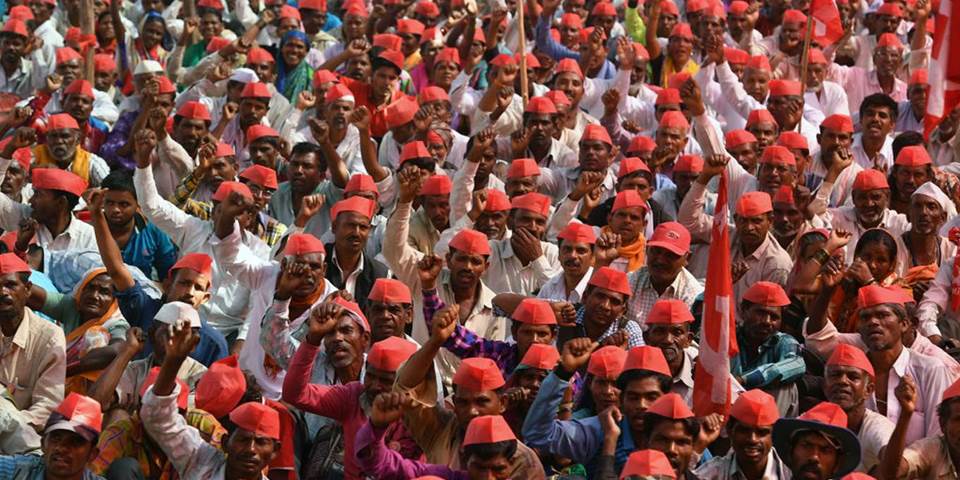
A set of three laws enacted by the Indian government in September this year, regulating the grain marketing process is mobilizing the rural population of India. Increasingly in volume, protesters move towards New Delhi demanding the revocation of the three documents that were collectively approved by the two legislative houses – o Lok Sabha (Lower House), in day 17, e o Rajya Sabha (Upper Chamber) – in 20 of September. They modify the traditional cereal marketing process that until then was done through the “Agricultural Production Market Committee” (APMC), advice created by state governments to ensure that farmers are protected from exploitation by large retailers. APMCs are currently regulated by state governments.
The Center says that the new legislation aims to protect farmers in the sale of their crops to agribusiness companies - both processors and wholesalers as well as large retailers and exporters. -, especially in the alienation of future crops, through a mutually profitable and agreed pricing scheme in a fair and transparent manner, inserted in the context of a modern system, that encourages entrepreneurship and free competition.
Then, why the protests?
It is worth knowing that the format adopted for decades, the Indian government guaranteed prices for certain crops, providing farmers with a long-term guarantee that allowed them to make investments for the next crop cycle. However,, these farmers were obliged to sell their goods at auction at the “Agricultural Production Market Committee” of their state., where they were guaranteed, at least, get the minimum price agreed by the government. By extension, transactions could only take place in market yards – “mandis” – and APMC. There were restrictions on who could buy at these auctions and prices were limited to essential goods..
The new laws defined by the government of Prime Minister Narendra Modi dismantle this structure, allowing farmers to sell their produce to anyone, and for any price. That is, farmers have more freedom to negotiate with any buyers and sell to other states. Modi says increasing competition in the market is a “good thing”, as it meets farmers' demands for a higher income and gives them new rights and opportunities.
This is because in 2017, the Central Government had observed that a series of reforms suggested by the then model had not been implemented, especially with regard to the smoothness and objectives of the process. It was noted that centralization resulted in reduced competition and a consequent reduction in the number of individuals and institutions involved., deriving to veritable monopolies of associations and abuse with regard to market rates, which was very harmful to the agricultural sector.
It should be noted that the issue is vital for India. Agriculture is the main source of livelihood for around 58% of the population of their 1,3 billion inhabitants. in political terms, also, Farmers are the largest electoral bloc in the country, making agriculture a central issue of Indian policy. So much so that on the date of enactment of the new legislation, Modi referred to the new system as a “watershed in the history of Indian agriculture”, as it strengthens the bargaining power of thousands of farmers.
The Center noted that before independence, in 1947, the government's main concern related to agricultural marketing was to keep in check the prices of food for consumers and those of raw materials destined for the industry. However, after independence, the need arose to protect farmers and provide them with prices that encourage the production of “commodities”. Became, So, problems with individuals and companies extorting large amounts of grain from the farmer at throwaway prices are very common across the country., as interest. Recognizing the hardships these farmers faced — such as losses from undue low values, higher marketing costs and considerable physical losses in the process of marketing products — the Government has introduced several mandatory regulations, hoping to establish a mechanism to monitor market conduct.
However, since the proposal of these laws of November, different protests have been taking place in different states of India, especially in Punjab and Haryana, where farmers are at the forefront in the country's agricultural production. Was, by the way, in these regions that the so-called “Green Revolution” took place, in 1965, during the government of Prime Minister Indira Gandhi, with the introduction of hybrid seeds, fertilizers and the implementation of irrigation techniques that made the country self-sufficient in food production. By the way, these are the first protests by large farmers since the government of Narendra Modi came to power, in 2014.
The move infuriated Indian farmers; they say the new rules will leave them exposed to the voracity of companies that exploit farm workers, who make up more than half of the workforce – near 480 millons of citizens – from India, according to the latest census, of 2011. Among these opponents are those who qualify the laws of “business-friendly and anti-farmer”, as is the case with opposition parties; between them, the “Communist Party of India” and a “Sikh” party – most Punjab farmers -, o “Shiromani Akali Dal”. One of the opposition's main dilemmas is the uncertainty surrounding the way in which reforms “will happen, actually”. Controversy surrounding minimum prices also weighs, the effect the new practice will have on intermediaries, the loss of State revenue and the low bargaining power of farmers. These are some of the fears that led the opposition to the streets.
Among the opponents stands out the renowned parliamentarian Shashi Taroor, who has extensive experience in the international context, having held relevant positions at the UN, inclusive. Your voice is heard by many opinion leaders. In an article published on the website “The Project Syndicate”, last year, he stated that…“Indian agriculture is in crisis. Farmers live in torment. During or mandate de Modi, the cost of inputs and, therefore, from cultivation, have increased alarmingly, while the prices of agricultural products and, consequently, of farm income, stagnated or fell… many farmers are bankrupt…when cultures fail, many farm workers who are under the overwhelming burden of debt (often derived from the usurious fees of rural moneylenders) commit suicide – as more than 11.400, in 2016.
It's hard to predict where the protests will go. Modi is unyielding, because he believes that this is another important step to “aggiornate” the agricultural sector, one of the bastions of the Indian economy. the protesters, by your side, fear becoming “slaves” of big business. In this "arm break", analysts judge that a lot of “water will pass under this bridge”. But what is at stake is fundamental for the survival of more than 1,3 billion people…
I recommend to friends to read Shashi Tharoor's text, that although old, remains current in many ways: Indian Farmers in Revolt
